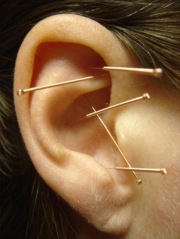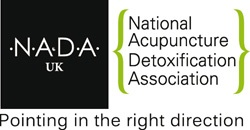

The NADA Protocol.
Acupuncture is an ancient Chinese medical procedure consisting of inserting fine, solid needles into specific points on the body in order to stimulate the body's natural tendency to resist or overcome ailments. The NADA Five Point Acupuncture Protocol is a standard, non diagnostic treatment for substance misuse and stress reduction. It involves placing disposable acupuncture needles into five auricular acupuncture points in the ear as stipulated by the National Acupuncture Detoxification Association USA, (NADA-US), and NADA-UK, for use within substance misuse and community treatment settings.
The treatment assists the withdrawal and detoxification process from toxic substances including drugs, alcohol and tobacco. These symptoms may include headaches, body aches, sweating, sleep disturbances, tremors, anxiety, anger and depression. Regular treatments can help to stabalise individuals physically and emotionally, increasing mental clarity and the ability to focus. It is a quiet, non verbal, relaxing treatment, stimulating the body to heal itself, and assists in rebuilding the physical and emotional self.
Recipients sit quietly in a non verbal group setting for up to 45 minutes, relaxing or meditating. The combined application of the NADA protocol in substance misuse settings providing counselling support, education, peer group, and self help support systems, enhance the opportunities for success in the various stages of detoxification, relapse avoidance and long term recovery.

Origins of auricular acupuncture
While the earliest uses of ear acupuncture points dates back to ancient China, modern applications of auriculotherapy are based on the work of Dr. Paul Nogier of Lyon, France. In the 1950's, Dr. Nogier noticed a strange scar on the upper ear of some of his patients. He found that all of them had been treated for sciatica pain by a local lay practitioner. This woman had cauterized a specific area of the external ear in order to relieve their low back pain. Dr. Nogier conducted a similar procedure on his own sciatica patients and found that their back pain was also reduced. He then tried other means of stimulating this "sciatica point," including the use of acupuncture needles, and found that they too were effective in alleviating sciatica pain.
The brilliance of Dr. Nogier was in extending this one observation into a more comprehensive model. Dr. Nogier theorised that if an area of the upper external ear is effective in treating low back pain, maybe other parts of the ear could treat other parts of the body. The ear is said to represent the whole anatomical body, but in an upside down orientation.
Nogier's theory contended that the auricle could be compared to an inverted fetus, with the head represented on the lower ear lobe, the feet at the top of the external ear, and the rest of the body in-between. This model was first presented to naturopathic practitioners in France in 1957, then spread to acupuncturists in Germany, and finally was translated into Chinese. The Chinese seemed to have adopted the inverted fetus model of ear acupuncture in 1958.

History of NADA protocol
In 1973 Dr. H. L. Wen - a neurosurgeon in Hong Kong - observed that electrical stimulation of auricular acupuncture points used for analgesic effect also alleviated the withdrawal symptoms of opium addiction in one of his patients. He tested this technique on other patients and it continued to be effective. In 1974, physiciatrist Dr. Michael Smith, already involved with a methadone maintenance program for addicts at Lincoln Memorial Hospital - a city facility in the South Bronx area of New York City -became aware of Dr. Wen’s findings. Dr. Smith continued to refine the protocol through experimentation, ultimately settling on the five points that would become the Acu Detox protocol, without electrical stimulation, to be retained for up to forty-five minutes by patients in a group setting. The five points in each ear help ease cravings and the emotional roller coaster of addiction and withdrawal, and also provide potent treatment for post-traumatic stress disorder. The five-needle protocol treats sleep disturbances, depression, and anxiety, often achieving instant results.
Benefits
The NADA protocol has been shown to help clients with the following:
- Reduction of craving for for the substance including prescription drugs
- A 'clearer mind' which promotes receptive rational thinking and therefore enhances the benefits of counselling and the group experience
- Reduction of withdrawal symptoms
- Improved sleep patterns
- Relapse
- Improvement of health problems which often accompany long term alcohol and drug misuse
- Marked relaxation, a feeling of well being
NADA in New York
In the aftermath of 9/11, the NADA protocol was used by St. Vincent’s Hospital in Manhattan as therapy for relieving emergency relief workers from insomnia and post-traumatic stress disorder (PTSD). For months, NADA was offered 24 hours a day on location at Ground Zero. Since 9/11 the use of the NADA protocol has been expanded to help treat recovery workers in disaster settings including New Orleans after Hurricane Katrina; the aftermath of the tornado which struck Joplin in Missouri; and the devastating San Diego wildfires.